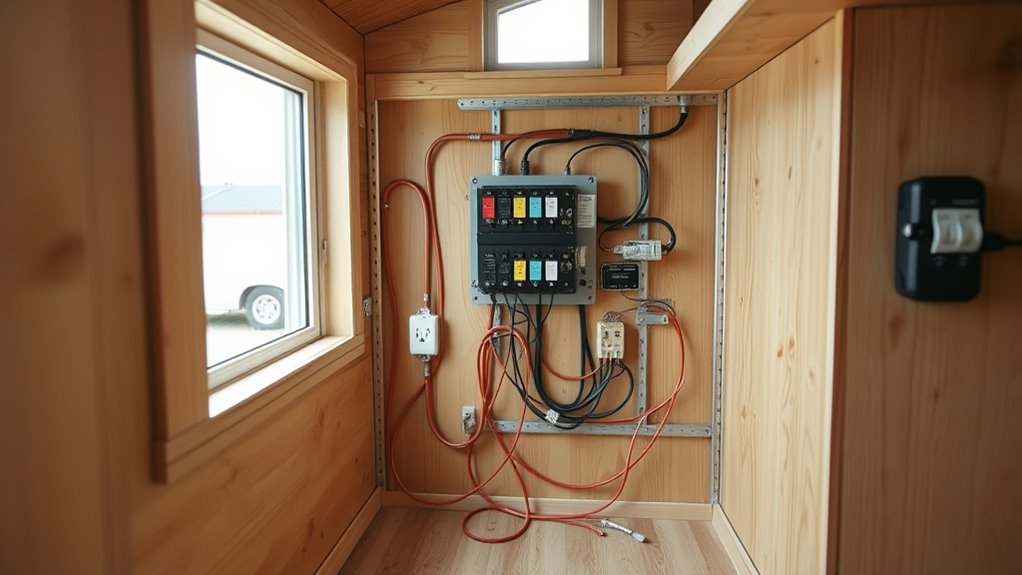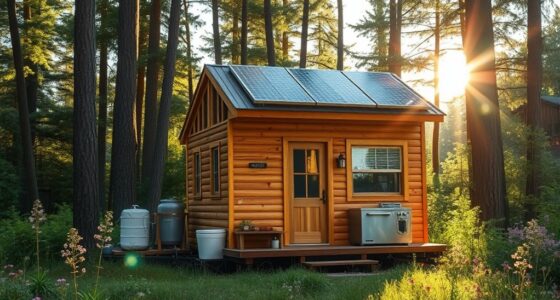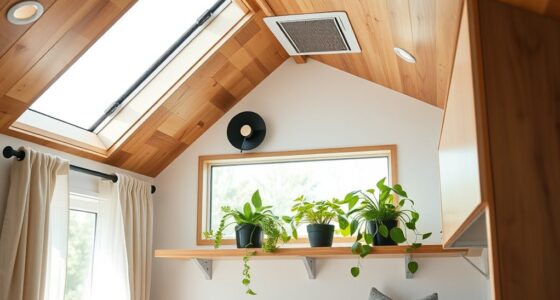To create an effective tiny house electrical layout, prioritize safety and efficiency by selecting quality components and working with licensed electricians. Incorporate solar panels thoughtfully to promote sustainability and reduce external power reliance, ensuring proper placement and safety standards. Use a centralized panel and neat wiring to maximize space. Install surge protectors, backup power sources, and follow local electrical codes. Staying organized and proactive with maintenance keeps your system safe and functional—keep going to discover even more tips for a successful setup.
Key Takeaways
- Plan a centralized electrical panel for easy wiring and future expansion.
- Prioritize solar panel placement for optimal sunlight exposure and space efficiency.
- Ensure all wiring complies with local electrical codes and use proper grounding techniques.
- Incorporate surge protectors and backup power sources to enhance safety and reliability.
- Work with licensed electricians to select high-quality components and ensure professional installation.

Designing an efficient electrical layout for your tiny house is crucial to maximize space and guarantee safety. When planning your system, integrating solar power can be a game-changer. Solar panels allow you to generate clean, renewable energy, reducing your reliance on external power sources and freeing up interior space that would otherwise be dedicated to bulky wiring or outlets. Position your solar panels thoughtfully, considering ideal sunlight exposure and proximity to your main electrical inlet. From there, plan for a charge controller and batteries that fit your energy needs, ensuring your tiny house remains self-sufficient without overloading your system.
Beyond harnessing solar energy, adhering to safety codes is non-negotiable. These codes are designed to protect you from potential electrical hazards, such as short circuits, overloads, or fires. Familiarize yourself with local electrical codes and standards, and incorporate their requirements from the outset. This might include proper circuit breaker placement, grounding procedures, and wire gauge specifications. Using code-compliant materials and following installation best practices helps prevent dangerous situations and simplifies inspections or future modifications.
Maximizing limited space means you need to think vertically and strategically. Opt for a centralized electrical panel to streamline wiring and make troubleshooting easier. Keep wiring neat and organized, using conduit or cable management systems to prevent damage and ensure accessibility. When planning outlets, switches, and fixtures, prioritize those you’ll use most often, and place them conveniently without cluttering your living space. Remember, a well-planned layout minimizes unnecessary wiring, which saves both space and costs.
Safety also involves planning for potential power surges and outages. Installing surge protectors and backup power solutions, such as batteries or generators, adds an extra layer of security. Make sure your electrical system can handle your household appliances and gadgets without risking overloads, especially since tiny houses often have limited capacity. Regular inspections and maintenance are essential to catch issues early; simple tasks like checking connections and replacing worn-out wiring can prevent accidents.
Additionally, understanding quality assessment principles can help you select durable and reliable components, extending the lifespan of your electrical system. Work with a licensed electrician when designing and installing your electrical system. Even if you’re handy, professional guidance ensures your tiny house’s electrical layout complies with safety codes and is safe for everyday use. Proper planning, adherence to safety standards, and smart integration of solar power will help you create a tiny house that’s both functional and secure, letting you enjoy your compact space without worry.
Frequently Asked Questions
How Do I Ensure Safety With Limited Space Electrical Wiring?
To guarantee safety in your tiny house electrical wiring, you need to focus on proper grounding techniques and circuit protection. Always connect your system to a reliable grounding source to prevent electrical shocks. Use circuit breakers and fuses to protect against overloads and short circuits. Keep wiring organized and accessible, and consult a professional to verify your setup. These steps help maintain safety despite limited space.
Can Solar Power Fully Support Tiny House Electrical Needs?
Yes, solar power can fully support your tiny house electrical needs if you install enough solar panels, a reliable solar battery, and maintain a grid connection for backup. By storing excess energy in the battery, you’ll have power during cloudy days or at night. A grid connection guarantees you won’t run out of electricity, providing peace of mind and a sustainable, self-sufficient power system tailored to your tiny house lifestyle.
What Are the Best Energy-Efficient Appliances for Tiny Homes?
You’ll find that energy-efficient appliances make a real difference in tiny homes. Opt for LED lighting, energy-star rated refrigerators, and low-flow faucets to maximize energy savings. Compact appliances like microwave ovens and portable dishwashers are also smart choices, reducing power consumption without sacrificing convenience. By carefully selecting appliances, you not only save energy but also free up space, making your tiny house more comfortable and sustainable.
How Do I Plan for Future Electrical Upgrades Easily?
To plan for future electrical upgrades easily, you should incorporate smart wiring and modular panels into your tiny house design. Smart wiring allows you to add or modify circuits without extensive rewiring, while modular panels make upgrading or expanding your electrical system simple. Always leave extra capacity in your main panel and plan for accessible wiring routes. This proactive approach guarantees you can upgrade efficiently as your needs evolve.
What Are Common Electrical Code Requirements for Tiny Houses?
Imagine your tiny house as a delicate garden needing careful tending. Electrical code requirements guarantee safety, like proper circuit protection and grounding techniques. You must install AFCI or GFCI outlets where needed and make sure your system is grounded correctly to prevent shocks and fires. Following these standards keeps your space safe and compliant, giving you peace of mind to enjoy your cozy home without worry.
Conclusion
Designing your tiny house’s electrical layout is like crafting a delicate symphony; each wire and outlet plays a crucial note. When you plan thoughtfully, you create a harmonious space where energy flows effortlessly, illuminating your journey with comfort and efficiency. Remember, a well-designed electrical system isn’t just wiring—it’s the heartbeat of your tiny home, fueling your adventures and dreams. Trust your plan, and let your tiny house shine bright with purpose and promise.









